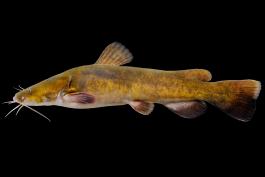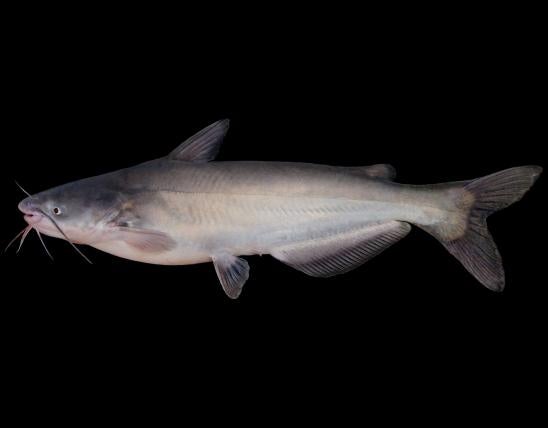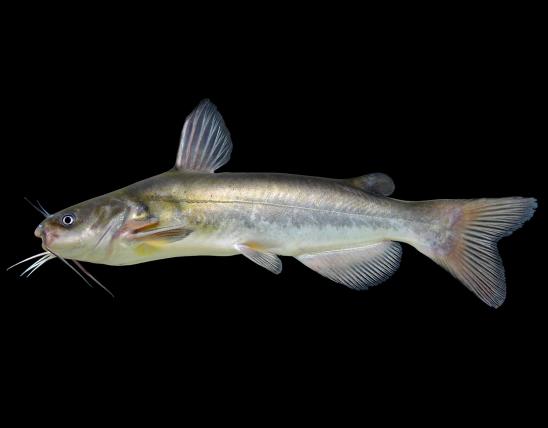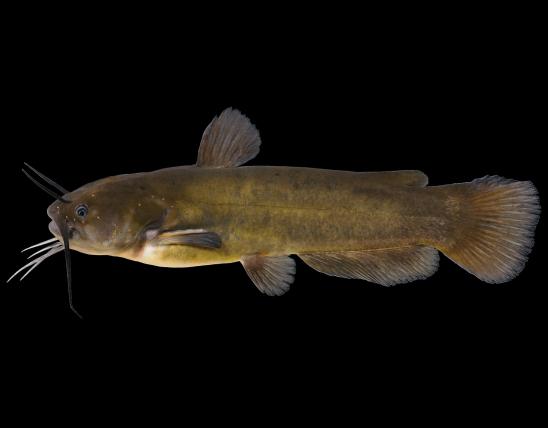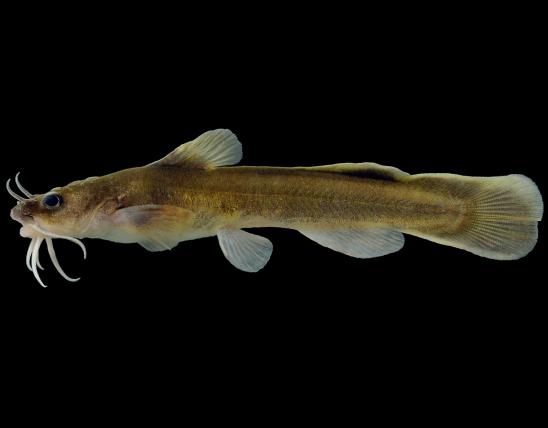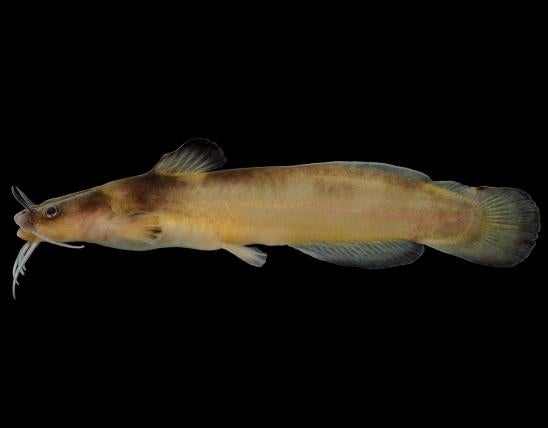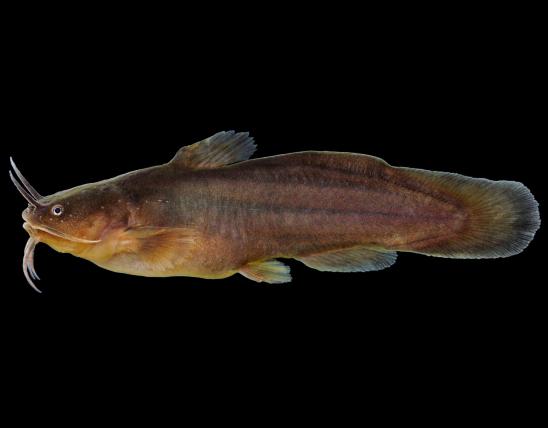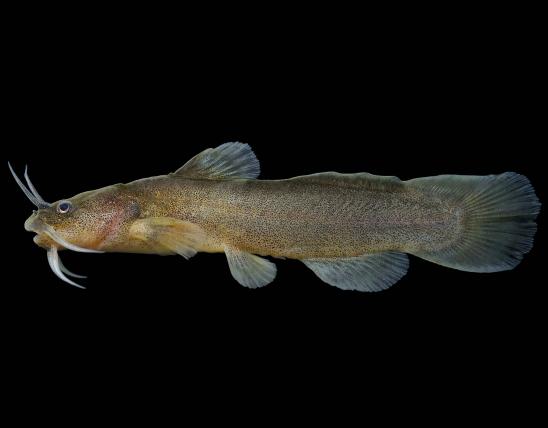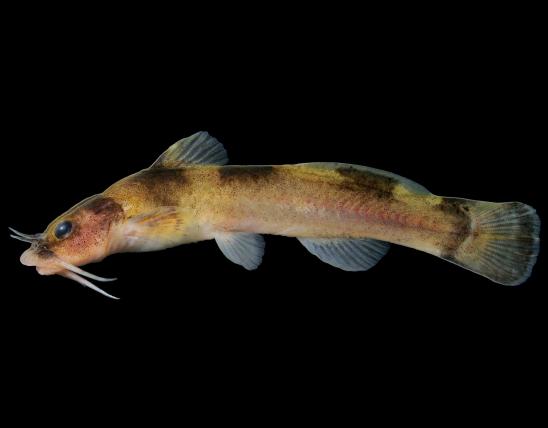
The flathead catfish has a broad, flattened head with small eyes on top. The lower jaw projects beyond the upper jaw. It occurs in most of the large streams of Missouri, preferring places with a slow current.
Missouri catfishes have smooth, scaleless skin and barbels (“whiskers”) around the mouth. The flathead catfish is distinguished by its broad, flattened head with small eyes on top, and the lower jaw projecting beyond the upper jaw. The tail fin is mostly squared off, with a slight notch (it is not deeply forked), and the anal fin is rounded, with 14–17 rays. The body is often strongly mottled with brown or black.
The back and sides are pale yellow to light brown or olive, mottled with dark brown or black (mottling is often poorly developed in adults from turbid water). The belly is pale yellow or creamy white. The tail fin is dark brown or black except for the upper lobe. The other fins are similar in color to nearby parts of the body. Young individuals are darker and more boldly marked than adults.
Similar species: There are 17 species of catfishes in Missouri. This is the only one with all the following characteristics:
- The adipose fin is a free lobe, widely separate from the tail fin.
- The tail fin is not forked.
- The lower jaw projects far beyond the upper jaw (except in the smallest young).
- The upper tip of the tail fin is lighter in color than the rest of the fin.
- The pad of teeth in the upper jaw has a backward extension on each side.
Adult length: commonly 15–45 inches; width: 1–45 pounds. Maximum is about 100 pounds.

Statewide in appropriate habitats: reservoirs and large streams with slow current.
Habitat and Conservation
The flathead catfish occurs in most of the large streams of Missouri. It is one of the most abundant of the larger catfishes in the Missouri and Mississippi rivers, in their principal tributaries of the prairie region of northern Missouri, and in the larger streams and ditches of the Bootheel lowlands. In the Ozarks, it is largely restricted to reservoirs and the downstream sections of the largest streams.
It inhabits a variety of stream types but avoids those with high gradients or intermittent flow. It is never found in headwater creeks. It achieves its greatest abundance in large rivers.
The young are often found among rocks on riffles, occupying much the same habitat as the stonecat and other riffle-dwelling madtoms. Adults occur in pools, near submerged logs, piles of drift, or other cover.
The flathead is a solitary species, and a single unit of cover, such as a drift pile, will usually yield only one or at most two or three adults. Each individual normally has a favorite resting place where it can be counted on to be each day unless disturbed.
Adults move at night from deeper water or cover to riffles and the shallows of pools to feed. The young remain continuously on the riffles but are active only at night.
Food
Flathead catfish forage at night. Smaller flatheads, less than 4 inches in length, eat insect larvae; adults prefer fish and crayfish and other crustaceans. Unlike channel catfish, they are not scavengers and rarely eat dead or decaying material.
Life Cycle
Flathead catfish spawn in late spring or early summer (late June and July), somewhat later than the channel catfish. A saucer-shaped depression is excavated by one or both parents in a natural cavity or near a large submerged object. The eggs are laid in a compact, golden yellow mass that may contain 100,000 eggs or more. The parent fish agitates the eggs continuously by fin movements during development to provide oxygen and flush away silt.
After the young have hatched and begun to swim, they remain for several days in a compact school near the nest. Soon, they disperse and take up a solitary life. The male guards the fry for about 7 days after hatching.
Flathead catfish become mature when 4 or 5 years old, or when they're about 18 inches long. Among Missouri catfishes, only the blue catfish grows larger than the flathead.
Human Connections
The flathead catfish is an important commercial and sport fish along the Missouri and Mississippi rivers and is commonly taken by sport fishers in large streams and reservoirs over most of Missouri.
Before the commercial fishery for catfish was closed in the Missouri River, the harvest of this species by Missouri's commercial fisherman was more than 208,000 pounds.
Sport fishers probably take more flatheads on trot lines than by any other method, but many are caught by jugging or by still-fishing with rod and reel. Methods are similar to those for taking channel catfish except that only live or freshly killed baits are effective.
In old-time Ozark dialect, flathead catfish were called "granny cats."
Ecosystem Connections
Flathead catfish are aquatic predators, but that doesn't mean they don't get preyed upon themselves. The young of even the largest species of fish are vulnerable to predation, and so are the eggs. This is one reason why catfish, and many other fish, have highly developed parental care, guarding their eggs and fry. Their nocturnal lifestyle is another defense against predation.



